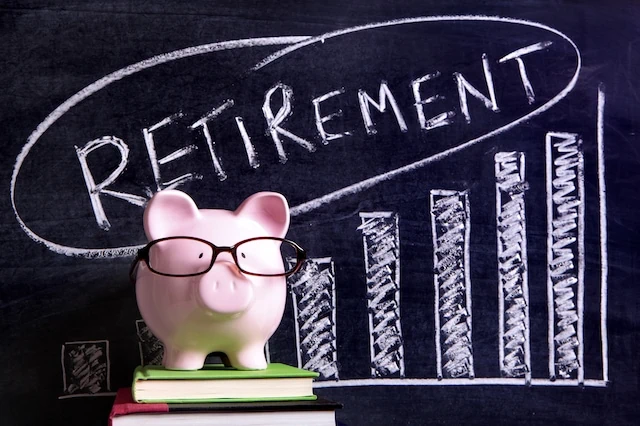Few financial topics cause more anxiety than retirement savings.
It’s easy to understand why: The size of a person’s nest egg is arguably the greatest factor in determining the quality of their post-career years … and, unfortunately, many Americans either aren’t sure whether they’ll reach their savings goals or are certain they won’t.
Consider AARP’s 2024 annual Financial Security Trends Survey, which polled more than 8,300 American adults over age 30 about various financial topics. Nearly a third of respondents (31%) said that, if they continued saving at their current rate, they weren’t sure whether they would have enough money to retire. Worse? A full third (33%) knew they would not have enough.
And if we had to guess, reading that has you asking yourself, “Where do I stand?”
Today, I’m going to talk about the average retirement savings by age group to give you an idea of how your savings currently compare to your peers. While your retirement savings needs might be different from others, these benchmarks can still give you a general idea of your progress. And with that knowledge in hand, you can start making the adjustments you need.
What Are The Average Retirement Savings by Age?

As part of this discussion, I’ll be using retirement savings data from the 2022 Federal Reserve Survey of Consumer Finances (SCF). The data is sorted into the following six age groups:
- Under age 35
- Ages 35 to 44
- Ages 45 to 54
- Ages 55 to 64
- Ages 65 to 74
- Age 75 and older
The Survey of Consumer Finances lists both median savings and mean (average) savings for Americans across all of a person’s retirement accounts. While you can make cases for both, we’ve gone for mean savings because there are caps on how much people can contribute to their retirement accounts, which limits the extent to which an outlier could impact the data.
Under Age 35

- Average retirement savings: $49,130
It should come to no surprise that the youngest age cohort has the lowest average retirement savings. Workers under age 35 have accumulated retirement savings of just more than $49,000 on average.
Among the things working against this group, which includes younger Millennials, Gen Z, and Gen Alpha:
- You can’t open your own brokerage account until you’re age 18.
- While there’s no minimum age to open an individual retirement account (IRA), you must have earned income to be able to do so.
- Many people in this age cohort aren’t even aware of how to save for retirement.
- People in this age cohort who have careers often make less than they will at any point in their careers, and also might be paying off student loans, so in general, they’ll have less available money to save.
- Some people in this age cohort who have careers still might not have access to a 401(k) or another workplace retirement plan.
- Most in this group have only started to benefit from the effects of compounding.
On top of all those natural limitations, many people simply don’t even begin to plan for retirement until they feel somewhat settled in the professional world (and until someone makes them aware of the need to save for retirement).
For all of these reasons, and more, it’s understandable that Americans under the age of 35 have relatively little saved up for retirement.
Related: Is Your Retirement on Track? Here Are the Average 401(k) Balances By Age
Ages 35 to 44

- Average retirement savings: $141,520
People between the ages of 35 to 44 have had more working years to contribute more to their savings, enjoy capital appreciation, and collect dividends and interest income. As a result, they have significantly higher average retirement savings, at more than $141,000.
However, the Center for Retirement Research at Boston College notes that the age group’s median retirement savings in 401(k)/IRAs was actually lower than it was in 2019—despite a roughly 64% total return (price plus dividends) for the S&P 500 between the start of 2019 and the end of 2022. Mean savings across all retirement accounts declined during this period, too.
Something else to note: This age range is a common time for people to start seeking advice from a financial advisor. According to Northwestern Mutual’s 2024 Planning & Progress Study, among people with a financial advisor, the average age a person started working with a financial advisor was 38.
But data hints that younger generations are seeking financial advice even earlier in life. Millennials with a financial advisor say they first sought out advice at age 29, on average. That’s nine years sooner than Gen X (age 38) and Boomers+ (49).
Related: How to Max Out Your 401(k) + Other Retirement Accounts
Ages 45 to 54

- Average retirement savings: $313,220
And naturally, as workers age, more and more things are working in their savings’ favor. Workers are earning more, likely have better benefits (specifically, 401(k) matches), and have had even more time for price gains and investment income to compound. As of the most recent Federal Reserve data, the 45-to-54 cohort has more than $313,220 set aside for retirement.
This cohort also benefits from an additional retirement-savings amplifier: catch-up contributions. Catch-up contributions are an additional sum that older adults can save over an account’s annual contribution limits, allowing them the opportunity to boost their savings in select tax-advantaged accounts. You can begin making catch-up contributions during the year in which you turn 50.
For instance, the 401(k) contribution limit for 2025 is $23,500 for an individual, up from $23,000 in 2024. Individuals age 50 to 59, and 63+, can add an additional $7,500 in catch-up contributions, while people age 60 to 63 have a “super” catch-up contribution limit of $11,250.
The IRA contribution limit for 2025 is $7,000, and the catch-up contribution limit is $1,000, so people 50 and over can contribute a total of $8,000 for the year. Both of these numbers are unchanged from for 2024.
Related: How to Invest for (And in) Retirement: Strategies + Investment Options
Ages 55 to 64

- Average retirement savings: $537,560
Full retirement age (by Social Security standards) is 66 to 67, which would seem to indicate that this age cohort is still fully of working age. However, Americans’ actual average retirement age is 62, according to MassMutual’s 2024 Retirement Happiness Study, so this group does indeed include at least some retirees.
People between the ages of 55 and 64 have an average retirement nest egg of more than $537,000, reflecting decades’ worth of both savings and growth. Many people in this group are also capable of socking much more away—a result of both a higher annual income and fading expenses (their own student loans are usually paid off, kids begin to finish college, mortgages become paid off, etc.).
That said, once people reach their 50s and 60s, they increasingly adjust their investment focus from wealth creation to wealth preservation. Put differently: Their retirement portfolios become more conservative in nature. It’s a necessity, but it does start to limit the growth potential of their savings.
Related: Want to Retire Early? Don’t Make These Mistakes
Ages 65 to 74

- Average retirement savings: $609,230
And, as you might expect, adults between the ages of 65 and 74 have the highest amount of retirement savings, on average stashing away some $609,000.
Most adults within this age group are either very close to calling it a career or completely retired. So, while at least some of these people are still contributing to retirement accounts, many are already withdrawing from their nest egg.
Also, according to the Social Security Administration, as of early 2025, roughly 90% of people ages 65 and older were receiving a Social Security benefit. Thus, the vast majority of people in this cohort are also collecting a Social Security check.
Related: IRA vs. 401(k): How These Retirement Accounts Differ
Age 75 and Older

- Average retirement savings: $462,210
The vast majority of Americans who are 75 and older have left the workforce. For instance, in a 2022 Gallup poll, 88% of respondents ages 75 and older said they were retired.
Most people in this age cohort are living off Social Security benefits and other sources of retirement income, which includes withdrawing from their retirement accounts. So naturally, it stands to reason that their average retirement savings balance, at more than $462,000, is actually quite lower than the 65-to-74 age group’s average.
Related: How Long Will My Savings Last in Retirement? 4 Withdrawal Strategies
How Else Do I Know Whether My Retirement Savings Are on Track?

While knowing how much other people your age have in retirement savings is useful, it doesn’t give you the full picture of how much you should have saved. Your cost of living may vary substantially depending on the location; thus, someone who lives somewhere with a high cost of living will need to save more than someone living somewhere more affordable. Additionally, people have different lifestyle expectations.
With that in mind, another way to track your progress is to consider Fidelity’s guidelines for how much you should have in retirement savings at the following ages:
- Age 30: 1X your annual salary
- Age 40: 3X your annual salary
- Age 50: 6X your annual salary
- Age 60: 8X your annual salary
- Age 67: 10X your annual salary
These guidelines assume you plan to retire at age 67. If you’re aiming for an early retirement, you would need to be more aggressive.
Obviously, both the by-age and by-annual-salary numbers provide an incomplete picture of exactly what you need to retire. If you want more comprehensive insights into your retirement goals, help with the retirement planning process or even, or even just have personal finance questions, it’s wise to discuss your needs with a financial advisor.
Related:






![Should You Max Out Your 401(k) Each Year? [Yes...and No] 19 should you max out your 401k each year or invest elsewhere](https://youngandtheinvested.com/wp-content/uploads/should-you-max-out-your-401k-each-year-or-invest-elsewhere-600x403.webp)

